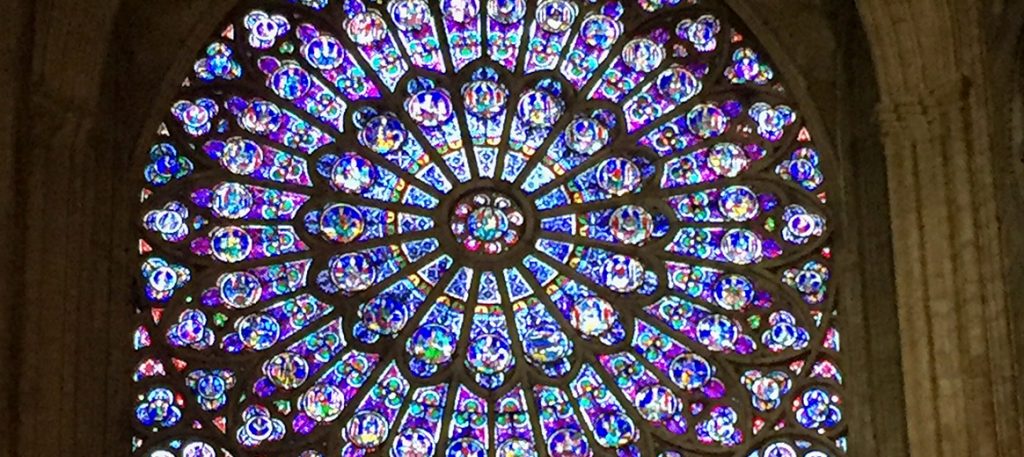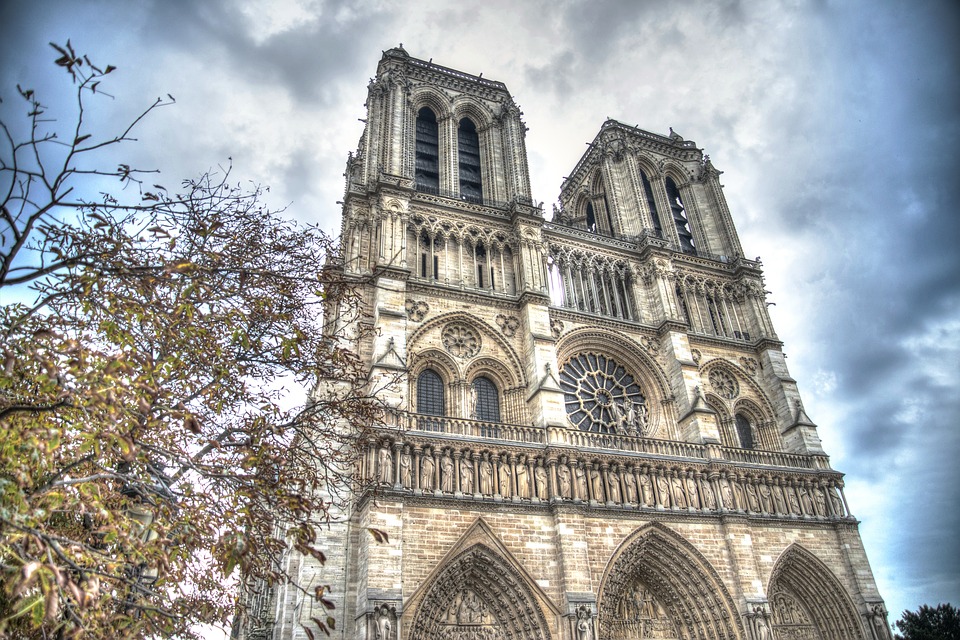We know now that much of the Notre Dame Cathedral survived and that it will be rebuilt. But while the fire at the Notre Dame Cathedral burned, Americans mourned. They didn’t just follow and repost the news. On social media they shared photos of themselves at the cathedral and reminisced and lamented. At my university, colleagues asked each other in the hallway if they’d heard the news and students whispered to each other about it before classes began. It was not at all unlike the way we treat the loss of a friend or a community member. The sense of shock and grief happened all over the country, across political divides, among people who were and were not Catholic, and very few of whom are Francophiles.
Notre Dame Cathedral rises in Gothic defiance of gravity, reaching up to the heavens, representing our seemingly universal desire to transcend the earth. Inside, light streams in from above, through windows that float at great heights and tell the story of the Christian faith. It is, like every church, a place to encounter the Divine. While the secular world flows around it, and tourists through it, it represents a space for the sacred in the middle of the city. Like other European Gothic cathedrals, it is the fruit of Catholicism. In its over eight hundred years, it has become a defining symbol of Paris. But it has also become a symbol of the past itself. Though the name “Notre Dame” refers to “Our Lady of Paris,” many people far from France or the Christian faith have reacted as though it is our loss. That is because the widespread affection for the Notre Dame Cathedral does not necessarily reflect a sharing of the values of the past as much as the acknowledgement of the value of the past.

Notre Dame Cathedral is a place where the past and present meet. While the city outside changed and charged ahead, inside the Cathedral you walked the same stones and gazed at light that poured through the same windows as people who lived centuries before you. The very architecture that inspired Victor Hugo, who lived and died before you were ever born, can inspire today. Those stones can form a link between us and the people of the past. While we often disdain our forebears, we can stand outside Notre Dame and be amazed at what human beings could do with plans drawn in the sand and executed with human strength and medieval engineering. Its endurance and beauty speak to us about the nature and potential of our humanity and the ends which our efforts can serve.
When the Crystal Palace burned in 1936, Churchill stood on a hill and watched, declaring it the “end of an era.” But the Notre Dame Cathedral represents more than a single era. It was already old when Paris erupted in the French Revolution of 1789. It endured the revolution of 1848, too, and the city-wide renovation of Baron von Haussmann that followed. It survived the Franco-Prussian War and the Nazi occupation. It will be rebuilt after this fire. Places like Notre Dame remind us that time does not just move in seconds, but in centuries. Anything that takes over a hundred years to build and far outlasts the memory of its builders can offer perspective on our own place in time. Architects, stone masons, and laborers came and went. We, too, will come and go. Many meaningful things will outlast us and many of the best things will not be defined by any one moment.
While the fire raged, it seemed everyone who had been to Paris reflected on their memories of Notre Dame because they knew we might lose something significant. In Remembrance of Things Past, Marcel Proust writes: “But when from a long-distant past nothing subsists, after the people are dead, after the things are broken and scattered, taste and smell alone, more fragile but more enduring, more unsubstantial, more persistent, more faithful, remain poised a long time, like souls, remembering, waiting, hoping, amid the ruins of all the rest; and bear unflinchingly, in the tiny and almost impalpable drop of their essence, the vast structure of recollection.” Proust was describing a sensory connection to the past. Places like the Notre Dame Cathedral, where we can touch a long-distant past, are an important part of the vast structure of human recollection. If the outpouring of grief seemed nearly universal, it is because the cathedral represents our shared need for the past.





2 comments
Eric Seaberg
I keep having to remind conservatives who have been posting – in the wake of the fire at Notre Dame – that our modern culture is incapable of building a beautiful cathedral – that this is a very odd perspective in light of Antonio Gaudi’s masterpiece (i.e. the “Cathedral Sagrada Familia”) that is still emerging in Barcelona, Spain over the past 100 years or so, and will be completed during this century. Certainly – most modern architecture is driven by a deadening modernist aesthetic, but Gaudi clearly demonstrates that it is still possible even in our own era – for a spiritually grounded Christian artist to create a cathedral that is every bit as sublime as the medieval creations continue to be. It just takes a beautiful vision & a beautiful aesthetic, a great deal of dedication and hard work, and a bit of help from the Holy Spirit (just read the backstory about how the plans for this cathedral were saved during the Spanish Civil War!).
Brian
“Decline starts with the replacement of dreams with memories and ends with the replacement of memories with other memories.” N.N. Taleb
The power of Notre Dame and medieval cathedrals in general comes from the fact that they were built to be beautiful and awe-inspiring, and we today, no matter our politics, religion, etc., know that we’ve completely lost that ability. Even here in America, where the building stock is so young, buildings from 100 years ago have beauty and show the confidence and pride and love of their builders for their cities and neighbors, and buildings from 40 years ago are grotesque and show loathing for their creators, viewers, and inhabitants. So the mourning that was expressed as the fire burned was for that beauty that our culture is incapable of creating. If we could, then one old building wouldn’t be such a loss. We were mourning the loss of community self-confidence and love that built Notre Dame but has long since faded away.
Comments are closed.